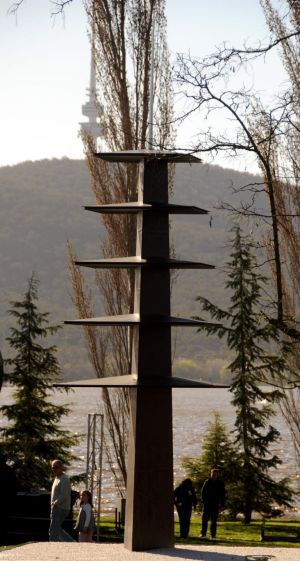The ACT government had to pay $86,000 to fix a $200,000 sculpture five years after it was installed because the sculptor failed to apply a proper primer, it can be revealed
Toku was unveiled in 2010 as a celebration of Canberra's sister-city relationship with the Japanese city.

Designed by Shinki Kato, it was modelled on Nara's five-story pagoda, built in 725 under the reign of Empress Komyoh.
But while pre-rusted steel plates were part of the design, a failure to apply a proper primer before painting meant there was more corrosion than intended.

The corrosion was discovered outside the warranty period which meant the territory had to foot the bill.
"It appears that the surface treatments have failed and that moisture has penetrated the fabrication causing widespread oxidisation and rust," a condition report noted.
"There does not appear to have been a suitable primer applied to the exterior surface prior to painting and the internal surfaces appear untreated which is in part responsible for the deterioration and current condition.
"The work also appears to have significant internal moisture which has migrated through the steel and become trapped between the outside steel surface and the paint as indicated by the aerated surfaces."
Canberra companies Art & Archival and Artillion were contracted in 2015 to save the artwork.
Kim Morris from Art & Archival said it required "serious intervention".
"It was severely rusted, the paint surface had cleaved well away from the metal substrate," Mr Morris said.
"Normally you wouldn't see that kind of corrosion in Canberra because the air is dry and there's not a lot of salt, you'd expect to see something like that in a coastal area."
Exacerbating the problem was a silicon additive in the paint that caused rust when it came into contact with the unprimed surface, an ACT government spokesman said.
"Analysis found the initial decorative paint coating on the sculpture contained a silicon additive used to create a 'hammered' visual effect," he said.
"This specialist artistic technique utilised by the artist had unanticipated consequences which were discovered outside the defects liability period, therefore the Japanese artist of Toku, Shinki Kato, did not contribute to the refurbishment cost."
Mr Morris said it was a "really serious and terminal problem".
"It was only a few years away from being completely unserviceable," he said.
"In another few years it would have been impossible to rectify. It would have meant the work had to be recreated or would have had significant parts cut out of it."
The restoration team had to dismantle the artwork and transport it to Queanbeyan.
Each piece was sandblasted to remove existing paint and rust, primed and spraypainted "like you would do a car" Mr Morris said.
Mr Morris said after its restoration, the sculpture had some minor cosmetic differences.
"It was never going to look the same as it did before," he said.
"To try to match the paint system and to get the appropriate level of protection was going to be impossible but the artist was happy for us to do it. It was saved and it should last quite well now."
The sculpture was one of two public art installations to undergo major conservation efforts last financial year.
The other was Circuitry by artist Fiona Hooton, which was sanded back and repainted at a cost of $30,000 last year.
This financial year, conservation works have been completed on Wide Brown Land at the arboretum, Owl in Belconnen and Moth Ascending the Capital in Tuggeranong.
"Environmental impacts on artworks in the public domain cannot always be fully anticipated and often require specialist maintenance and refurbishment works to avoid further damage. The careful refurbishment and maintenance of artworks generally limits the need for future maintenance," the ACT government spokesman said.
